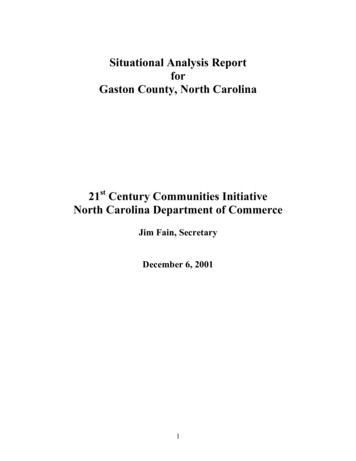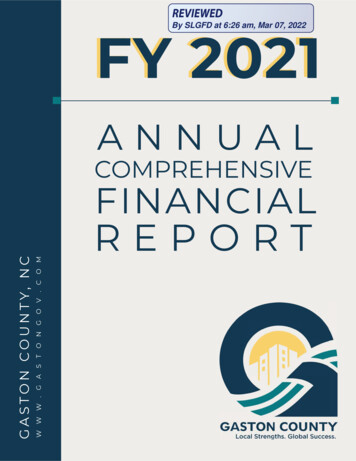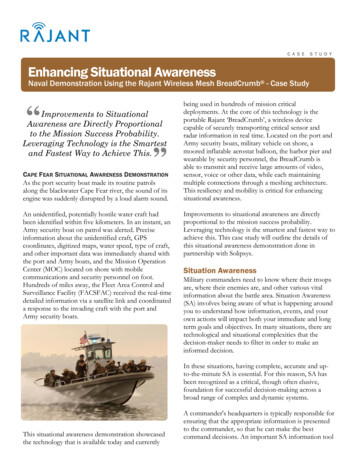
Transcription
Situational Analysis ReportforGaston County, North Carolina21st Century Communities InitiativeNorth Carolina Department of CommerceJim Fain, SecretaryDecember 6, 20011
Table of ContentsI.Introduction - The 21st Century Communities Initiative. 3II.The Process for Implementing the Gaston County 21st Century CommunitiesInitiative. . 4III.Overview of Gaston County . 5IV.Executive Summary of the Key Issues identified in Gaston County by theCommerce Resource Team. . 7V.A Listing of the members of the North Carolina Department of CommerceResource Team that conducted interviews of 74 individuals in Gaston County onOctober 30-31, 2001 . 13VI.Gaston County Economic Development Roundtable Recommendations . 14VII.NC Department of Commerce Recommendations: . 16VIII.The Next Steps in the 21st Century Community Process. 16IX.Timeline of Events for the 21st Century Communities Initiative during the next12 Months (Tentative): . 17Appendix:Gaston County Profile and Statistics .182
I.IntroductionThe 21st Century Communities InitiativeNow more than ever, North Carolina’s prosperity is tied to global economic influencesthat sometimes work against our collective success. Families and communities can berocked by layoffs and plant closings. An agrarian economic foundation once gave way tothe manufacturing base that has driven North Carolina’s economy for decades, but nowwe’re moving toward an economic engine powered by knowledge and service industries,and higher value-added manufacturing. The NC Department of Commerce is preparedto work with local communities across the state to move North Carolina forward in thenew global economy. The 21st Century Communities Initiative will create newpartnerships between the state and designated counties to build new strategies foreconomic vitality.How the initiative will work:Ten counties across the state - Columbus, Cherokee, Duplin, GASTON, Halifax,Robeson, Rockingham, Rutherford, Warren and Yancey – will partner with theDepartment of Commerce and appropriate local, regional, state and federal agencies andleaders to rapidly develop economic game plans tailored for each county. The goal iscommunity readiness – using existing Commerce resources in a focused, knowledgedriven approach to help assess the individual economic challenges faced by the counties.Every division in the Department of Commerce will collaborate with the counties toconduct a thorough analysis of local strengths, challenges and obstacles to success. Boldinitiatives to maximize the full potential of each county will be developed in partnershipwith local leaders. Commerce will work closely with counties to carry out the economicgame plans tailored for each county.Strategies for local communities:In economic development, one size doesn’t fit all. The 21st Century CommunitiesInitiative will offer, broker or facilitate a variety of existing Commerce services asneeded, including but not limited to: economic development strategy planning;community planning; product/real estate development; tourism planning; infrastructureimprovement; customized community marketing; intergovernmental collaboration;downtown revitalization assistance; workforce development; and leadershipdevelopment. Commerce has developed a community resource catalog to help localcommunities identify the existing Commerce services that can help quickly.Future 21st Century Communities:At the end of the first year, the Department of Commerce will assess the initiative’seffectiveness and make necessary changes in the program. At that time, it is anticipatedthat new 21st Century Communities will be identified on the same criteria at the firstparticipants, including unemployment rates, percentage of workforce in traditionalmanufacturing sectors and local community leadership and interest in the program.3
II.The Process for Implementing the Gaston County 21st CenturyCommunities Initiative.As previously stated, the 21st Century Communities program creates a newpartnership between the State and Gaston County to build a new strategy foreconomic vitality. A special North Carolina Department of Commerce (DOC) taskforce is joining with local officials in developing these specific strategies and willcontinue working with Gaston County over the long term to help implementrecommended changes. The goal is community readiness and preparedness foreconomic development. The strategic planning involved in this process is recognizedas a continuing process that must be flexible and adaptable. This process involves thefollowing major activities or steps: County self-evaluation by the Gaston Economic DevelopmentCommission (EDC).Statistical Analysis by the DOC’s Policy and research Division andbackground information to assist with the forthcomingreconnaissance study.In coordination with the Gaston County EDC, a DOC task forceconducts a two-day reconnaissance study and evaluation of GastonCounty that involves interviews with numerous community andbusiness leaders and local governmental officials.The DOC task force involves representatives from the Divisions ofBusiness and Industry, Community Assistance, Travel andTourism, Workforce Development, Policy and Research, andDOC’s USDA-Rural Development.Based upon the reconnaissance study, the Salisbury RegionalOffice of the Division of Community Assistance and the CarolinasRegional Office (Charlotte) of the Business and Industry Divisionwill prepare a Situational Analysis Report and present the reportand its findings at a community kick-off meeting that will be heldin early December, 2001.With assistance from DOC, Gaston County will organize for astrategic planning process that may involve the appointment of asteering committee and ad hoc committees to identify issues andstrategies; and identifies tailor-made processes on how to proceedwith the implementation of existing and future economicdevelopment strategies.DOC task force agencies will continue to work with GastonCounty officials on the identification and implementation ofadditional economic development strategies.At the end of the first and each successive year, DOC and GastonCounty officials will review and evaluate the program’seffectiveness.4
III. Overview of Gaston CountyHistory and Recent DevelopmentsCatawba Indians and other Native Americans populated Gaston originally. In themid-18th Century, early settlers began moving down from the northeastern states.They included Scotch-Irish, Pennsylvania Dutch and English immigrants anddescendants, who found the warmer climate more conducive to farming. The areasoon attracted miners because of its deposits of gold, iron, sulfur and tin.Gaston’s strong rivers provided waterpower for cotton mills beginning in the1840’s, as later hydroelectric energy to drive other facilities. Although its economycontinues to diversify, Gaston County still leads the United States in yarn and threadproduction, with more spindles in operation and more cotton bales consumed thanany other U. S. location. Gaston is also a world leader in advanced textile technologyand automation.Supplying all that textile equipment with parts and machinery has also madeGaston one of the largest centers of metalworking firms in the U. S., with more than200 companies employing over 6,000 people. Today, some of that metalworkingskill serves a major Freightliner truck manufacturing facility and other automotivecomponent producers. A wide variety of plastic products, power tools, electricalgoods and components, motor oil filters, paper products and many others are alsomade in Gaston. Following manufacturing in order of local employment are retail,government, service, and transportation-communications-public utilities.Gaston County residents also benefit from the state’s fifth largest school system,two colleges and a textile technology institute. Caromont Healthcare has over 450beds, a state-of-the-art cancer treatment center, and continues to grow as one of thetop medical resources in the region. The Schciele Museum of Natural History and theDaniel Stowe Botanical Garden attract visitors and tourists from many states. In all,Gaston County offers a full spectrum of opportunities for quality of life and work.Note: The above information was taken from Gaston County Fact Book 2001, GastonCounty Economic Development Commission.Location and GeographyGaston County is located in the south central “Piedmont” section of NorthCarolina, immediately adjacent to the western side of Charlotte and MecklenburgCounty. It is bounded on the south by York County, South Carolina, with LincolnCounty to the north and Cleveland County to the west. Gaston is midway betweenthe Florida Keys and New England, and just 200 miles from the Atlantic Ocean,making it a strategic center for serving the entire Eastern United States.5
The county includes approximately 364 square miles of diverse topography,mostly gently rolling hills. Higher elevations include Kings Mountain Pinnacle at1,705 feet above sea level, as well as Spencer Mountain and Crowders Mountain.These low “mountains” are the first that the traveler sees moving west from Charlotteon I-85. Average elevation in the county is estimated at 825 feet.The county’s climate has an average temperature of 60 degrees year-round, 78 insummer and 43 in winter. Average annual precipitation is 44 inches, and averagerelative humidity is 54 percent. The Catawba River and its South Fork tributaryprovide major natural drainage as well as abundant boating and fishing opportunities.Note: The above information was taken from Gaston County Fact Book 2001, GastonCounty EDC.Many Municipalities in Gaston CountyGaston County has 14 municipalities within its boundaries – the largest beingGastonia, the county seat, with a 2000 population of 66,277 and the smallest beingSpencer Mountain with a 2000 population of 51. The individual cities and towns andthe year they were incorporated are listed as follows:Belmont(1895)Bessemer City (1893)Cherryville h Shoals (1973)Kings MountainLowellMcAdenvilleMount HollyRanloSpencer )(1855)Gaston County was created on December 21, 1846, by the North Carolina StateGeneral Assembly. The area which comprises modern day Gaston County wasformerly part of Lincoln County, that abuts Gaston’s northern boundary. The countywas named for the Honorable William Gaston, Associate Justice of the SupremeCourt. Dallas was the original County Seat and held that title until 1911 when a thirdattempt to move the County Seat to Gastonia was finally successful. Gastonia hasmaintained the title ever since. Gaston County is governed by a seven-member Boardof Commissioners.Gaston County Comprehensive PlanA Gaston County Comprehensive Plan is currently being prepared and a series ofplanning forums were completed in August 2001. Information gathered from thosemeetings is being used in the development of 5 Small Area Plans, upon which the finalcountywide plan will be based. Considerable information on these forums can beobtained by clicking on the Gaston County website at: http://www.co.gaston.nc.us/6
IV. Executive Summary of the Key Issues identified in GastonCounty by the Commerce Resource Team.On October 30 and 31, 2001, a ten-member team of North Carolina Department ofCommerce staff, representing many of the Department’s Divisions, visited GastonCounty and interviewed 74 community leaders about their views of the county’s localeconomic development issues. The individuals that were interviewed includedcounty and municipal elected officials; local governmental administrative andprofessional staff; officials associated with utility companies; bank officers;Community College officials; real estate developers; people involved with tourismand museum activities; merchants; industrialists, and other such civic leaders. Eachinterviewee was given in advance a set of 29 questions that asked about their opinionson such issues in Gaston County as: Strengths, weaknesses and recent trends,Infrastructure,Labor force,Recruitment and incentives,Environment,Partnerships,Quality of Life,And concluded with several questions of a general nature.The participants were encouraged to be candid and forthright and were likewiseassured that their comments would not be identified by their name. The purpose andintent of this report is to summarize the content of the 74 interviews, referencing andhighlighting the more often and frequently cited issues.The October 30 – 31 interviews determined a general consensus regarding whichwere the most important issues facing Gaston County as it moves into the 21st century.The Department of Commerce interview team reached agreement that the followingpoints of public concern were those that were foremost in the minds of the interviewparticipants. The 5 Major Issues have been identified as follows:1.The perception of Gaston County having a negative image.2.Growth management.3.A need for a “shared vision” for Gaston County’s desired future.4.Transition from traditional manufacturing jobs to more diversifiedemployment opportunities in the future.7
5.Coordination/cooperation between the county government officialsand the officials from the many units of municipal government inGaston County.Other Observations and Comments by the Gaston County Participants that werediscussed during the October 30-31, 2001 Interviews by topic.Strengths of Gaston County for Economic Development: LocationProximity to City of Charlotte and Douglas International AirportGood highway systemAffordable real estateAvailable buildings and building sitesGaston Community CollegeGreat local support for Gaston Community CollegeCultural attractions:Daniel Stowe Botanical GardenSchiele Museum of Natural HistoryCrowders Mountain State ParkC. Grier Beam Truck MuseumGaston County EDC and its professional staffLabor source with a strong work ethicExcess capacity in infrastructure, especially availability of waterCountywide zoning protectionQuality of lifeGood climateSome recent diversity in industryComprehensive Land Use Plan now being preparedCherryville Industrial parkGood school system (and recent passage of school bond issue)Strong hospital and healthcare facilitiesGastonia City Council is showing strong leadershipGastonia’s “All America City” designation during 2000Charlotte must grow and its economic development growth will grow intoGaston CountyAttractiveness of Downtown Belmont activitiesFriendly/outgoing citizensNumerous recreational facilitiesWeaknesses of Gaston County for Economic Development Literacy rate – 39% of county adults do not have a high school degreeDowntown Gastonia8
(Weaknesses-continued) County image and perception Declining tax base Relatively high tax rate Lack of confidence in elected leadership Lack of countywide water and sewer service Lack of a shared vision for desired future development Duplication of EDC efforts by other organizations Dependence upon textiles Lack of parental and family emphasis on the value of education Unsightliness of Franklin Boulevard Big disconnect between “workforce development” and “economicdevelopment” An attitude of independence and resistance to change by many residents Confusion about land use regulations since there are so many differentmunicipal zoning ordinances in the county Traffic congestion along I-85 and US-321 Education system doesn’t adequately prepare workforce Too much emphasis on manufacturing and not enough on economicdiversity Loss of textile jobs and the textile heritage Poor political climate between county and municipal governments Inadequate public transportation Lack of a Civic Center Smaller municipalities lacking resources Cherryville is 15 miles from nearest 4-lane highway Difficulty in hiring people with basic reading, communication and mathskills Complacency and satisfaction with the status quo Northwest corner of Gaston County is isolatedEnvironment, Partnerships and Quality of Life Issues in Gaston County Revitalization of downtown Gastonia is extremely importantComprehensive Land Use Plan underway.Air quality – non-attainment level/increased ozone levelWater qualitySedimentationGround water contamination and failing septic tanksBuffers along waterwaysImage – self-perpetuating “Blue Collar”Need to develop a “Vision” that is embraced by allFriendly people9
(Environment – continued) Good race relations Excelling quality of life as a community Enjoyable place to live Firestone/Luray Mill preservation project has tremendous potential Now is the time, climate and environment to make some real progress inpromoting economic development activities EDC needs to freely operate without obstacles being thrown up in front ofit Stowe Garden and Schiele Museum are nationally recognized facilities Potential for travel and tourism Easy access to sporting events in Charlotte Providing water to Clover, SC Working with Voices and Choices to improve Catawba River EDC has been helping build partnerships between the municipalities There is some ground water contamination and failing septic tanks Hydrilla growth in Mountain island Lake Urban sprawl and “creeping development congestion” Lots of churchesInfrastructure Countywide water and sewerMunicipal investment in current water and sewer (excess capacity)Toll road (US-321-74 bypass)Widening of NC Highway 279 to 4-lanes from Cherryville to GastoniaNeed for Civic CenterInvest in Downtown Gastonia infrastructureBuild a shared visionPublic transportation in eastern part of county onlySchool bond issue (passed on November 6, 2001)A Visitors Center is neededThe completion of I-485 will be a plus for Gaston CountyGastonia has a transportation plan (MPO), Community Transit ServicesPlan, Bike Plan and a Greenway PlanNeed more developed industrial parksGaston County Airport needs to be expandedLabor Force Lack of education (illiteracy and the high drop-out rate)Skill shortage for future jobsLack of parental emphasis on education10
(Labor Force – continued) Disconnect between workforce development and EDC (reactive, notproactive) Available training slots not being fully utilized Strong work ethic of Gaston County workers Public schools are not adequately preparing the workforce Health care is an expanding field in Gaston County Highland High School magnet school is a positive step Gaston College is well positioned and willing to target, train and retainworkers Students won’t sign up for skill classes needed – machinery, HVAC,industrial maintenance, welding. These classes are hard to market Need re-education training dollars for a qualified work force There are not enough new opportunities to sustain the workforce Thousands of middle-aged, unemployed workers with low educationlevels that are in need of re-training Many complaints from high tech firms that high school graduates can’tread and do math at the ninth grade levelRecruitment and Incentives Many positive comments about the EDC and its staffNot all the municipalities are supporting the EDCIncentives for smaller businessesHigh water, sewer and electrical rates in some municipalitiesCounty has a good incentive package and the EDC uses them effectivelyMany sites and buildings are availableGreater industrial diversification is neededNeed for more white-collar jobsOverall, there is a lack of vision and identity for the types of business andindustry to recruitSpecialized technology center – “Center of Excellence” (Example –automotive)Combine services and utilities between municipalities and/or countyTax incentives needed to recruit businessImprove the image of Downtown Gastonia to assist in recruiting industryDeveloping small business is criticalCounty tax rate is too highIt is generally agreed that the EDC is highly regardedOther Issues Planning- countywide zoning adopted in 199211
(Other Issues – continued) Lack of coordination/communication between governmental units County leadership void Missing a new generation of community leadership Vision – need to develop a shared vision for the future Sense of independence in the past has become a problem today Strong sense of community by municipalities Lacking sense of “County community” Need to cooperate now Tourism will play a larger role in the future economy Effective planning and coordination will be a challenge Need to constructively engage business leaders in meaningful civicprojects Improve political climate in county Considerable discussion about the need for improving DowntownGastonia Need to employ a highly skilled county manager and no “micromanaging” by county commissioners Implement “smart growth” techniques Need for monthly meetings of mayors, city managers, county officials andEDC to develop strategies to market Gaston County as a whole Recruit distribution centers to utilize empty textile buildings Character of individual communities is too diverse to expect unifiedordinances Gaston should work off the strengths of its close proximity to Charlotte12
V.A Listing of the members of the North Carolina Department ofCommerce Resource Team that conducted interviews of 74individuals in Gaston County on October 30-31, 20011. Barbara Bergman, Employment and Training Specialist, Employmentand Training Division, NC Department of Commerce, Raleigh, NC2. John Berndt, Assistant Director, Division of Community Assistance,NC Department of Commerce, Raleigh, NC3. Richard Clark, Heritage Tourism Manager, Tourism, Film & SportsDivision, NC Department of Commerce, Raleigh, NC4. Ray Denny, Director, Business & Industry Division, NC Department ofCommerce, Raleigh, NC5. Jim Dunn, Chief Planner, Salisbury Regional Office, Division ofCommunity Assistance, NC Department of Commerce, Salisbury, NC6. Kenny Flowers, Director, NC Rural Development Council, NCDepartment of Commerce, Raleigh, NC7. Nann Guthrie, Senior Field Officer, Asheville Regional Office, NCDepartment of Environment & Natural Resources, Asheville, NC8. Jim Haag, Director, Policy and Research Division, NC Department ofCommerce, Raleigh, NC9. Ron Leitch, Economic Development Representative, Carolinas RegionalOffice, NC Department of Commerce, Charlotte, NC10. Jack Newman, Community Development Planner, Salisbury RegionalOffice, Division of Community Assistance, NC Department of Commerce,Salisbury, NC13
VI. Gaston County Economic Development RoundtableRecommendationsOn the evening of Tuesday, October 30, 2001, the Department of CommerceResource Team was invited to attend an “Economic Development Roundtable”discussion that was hosted by the Gaston County Commissioners. TheCommissioners invited 12 local business leaders to the meeting to present theirideas and recommendations in an effort to develop strategies for addressingeconomic development initiatives, specifically how they could help in recruitingand retaining local industries. Since the mission of the Round Table discussion islikewise that of the 21st Century Communities Initiative, the DOC supports thateffort and reiterates these valid recommendations that were proposed at themeeting. Those recommendations that were presented for County Commissionaction are identified as follows:1.2.3.4.5.6.7.8.9.10.11.12.13.Recognize importance of and seek opportunities to be a regionalpartner particularly for joint Gaston County Eastside and CharlotteWest side development. This will enable the county to jointlydraw on state resources.Develop a clear vision for the future.Support education improvement.Audit industries to get a clear picture of related needs.Include existing businesses in incentive plans.Development a plan or structure that identifies the return oninvestment for recruitment and incentives.Use vacant buildings (6 million sq. feet in 60 buildings) as an assetto attract business and promote adaptive re-use.Monitor and control cost of energy.Continue to fast-track permits through rapid responsiveness forprojects.Focus incentives “up-front” with as much flexibility as possiblewithin state guidelines.EDC response:- Abate in net new revenue- William S. Lee Act with State- Use 1 million threshold for existing expansion- Provide development team quickly to support new businessand existing business expansionRegulations cause home costs and tax costs to be highest in region.Neighborhood schools attract buyers, but costs are a problem.Consolidate permitting between municipalities, particularlyGastonia and the County.Target more funding to expand EDC.Improve government efficiencies.14
14.15.16.17.Support downtown redevelopment for Gastonia because ofimportance in decisions of individuals to locate in the community.Support road development – opening US-321 By-pass will opendevelopment opportunities for office buildings and distributioncenters connecting cargo and trucking.Implement Quality Program.Bring together groups to work collaboratively to address economicdevelopment needs.Opportunities for Industry Support and Involvement:1. Continue to hold round table discussions to involve other businessleaders including a number of smaller meetings that also include smallbusiness.2. Open EDC meetings and promote an opportunity to address businessquestions.3. Use industry leaders to work with EDC as ambassadors in recruiting aswell as to connect to our community – golfing, arts, museums,communities, etc.4. Use business leaders as resources on best practices, feedback onperformance, quality initiatives, efficiency evaluations.5. Participate in planning initiatives.6. Use information provided by county to “sell” the community tobusiness contacts.15
VII. NC Department of Commerce Recommendations:Community preparedness and readiness for economic development requiresconsiderable commitment and focus on strategies that will secure economic prosperitynow and in the future. Many of these strategies will need to be pursued simultaneouslyand will require flexibility and perseverance to assure the implementation of significanteconomic development strategies. It is imperative that Gaston County, in preparing foreconomic development and desired growth, will need to have the following: A well-trained workforce.Intergovernmental coordination and cooperation.Water and sewer systems capable ofaccommodating future growth.Available buildings and industrial sites served byappropriate supportive infrastructure (water andsewer services, natural gas, and transportation).High quality of life that includes good schools,recreation facilities and shopping.A growth management policy and guide that directsgrowth to appropriate areas.Local incentive and investment policies.A cooperative and progressive community spirit.A list of community preparedness tools and attributes beneficial to the recruitmentof new business appears on the following page. All communities have room forimprovement and to recognize this fact is the first step toward preparing for economicdevelopment. The leadership of Gaston County must now determine which issues are ofa high priority and therefore develop strategies and implementation tools to adequatelyaddress those issues.VIII. The Next Steps in the 21st Century Community ProcessGaston County has accomplished several positive actions towards improving itslocal economy. Bringing business leaders together with the county commissioners forthe Economic Development Roundtable discussion was an excellent means of openingcommunication lines between the public and private sectors. The Gaston CountyEconomic Development Commission and its Executive Director and staff are consideredto be outstanding. Gastonia, even with its downtown problems, was recently awarded an“All America City” designation. The county should be commended for having aComprehensive Land Use Plan under way as it awaits its publication in the summer of2002. The 74 participants in the Commerce Resource Team interviews expressed anoptimism that now is the time and environment for the proper public-private partnerships16
to be established that would develop an implementation plan and process to direct themany resources of Gaston County, its 14 municipalities, the Charlotte Region and theState of North Carolina towards growing a more vibrant local economy. With thisprocess, local leaders and state officials can identify and prioritize the greatest needs ofthe Gaston community and match them with the available state resources to best preparethe county for a stronger and more resilient economy.The key to this program’s success will be the development of a localimplementation strategy, devoid of politics, that will systematically prioritize strategies,identify needed resources, assign responsibility for implementation, define a time-framefor implementation and annually evaluate each strategy as to its effectiveness. The NCDepartment of Commerce will partner with the Gaston County implementation team toidentify any and all Department and other available state resources available to helpimplement those identified strategies.IX. Timeline of Events for the 21st Century CommunitiesInitiative during the next 12 Months (Tentative):January 2002 ---------- Gaston County Implementation Committee organization.February 2002 -------- Review and Prioritize Strategies.April 2002 ------------ Committee Prepares Implementatio
in early December, 2001. With assistance from DOC, Gaston County will organize for a strategic planning process that may involve the appointment of a steering committee and ad hoc committees to identify issues and strategies; and identifies tailor-made processes on how to proceed with the implementation of existing and future economic










